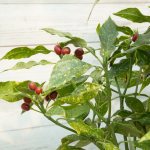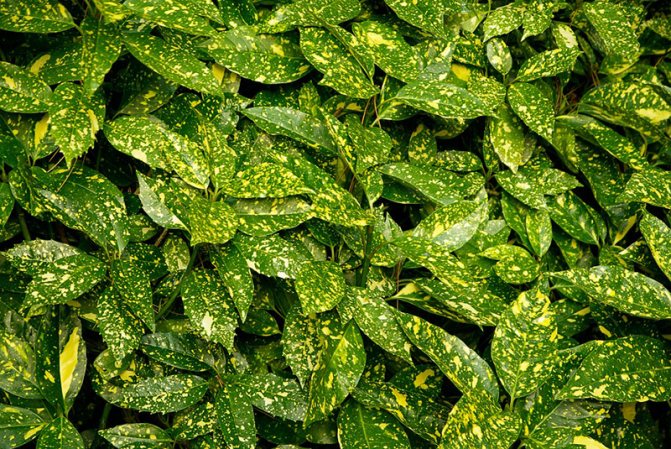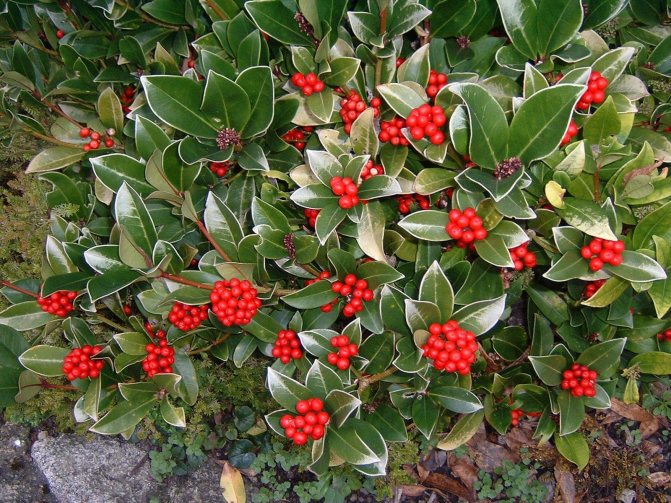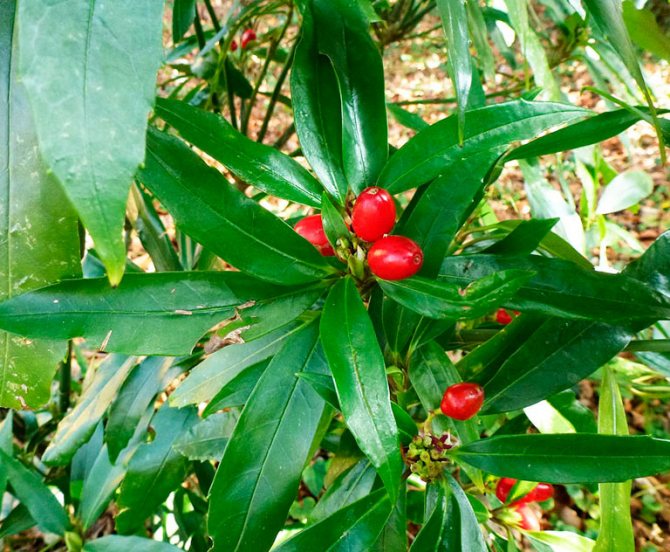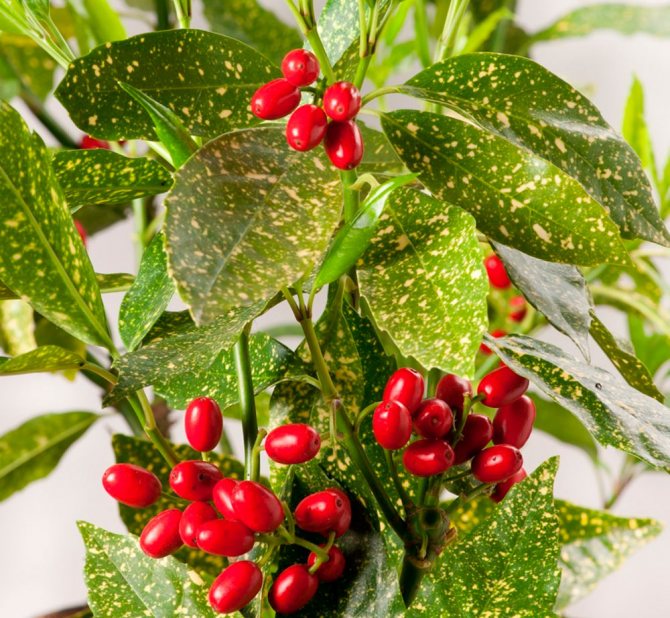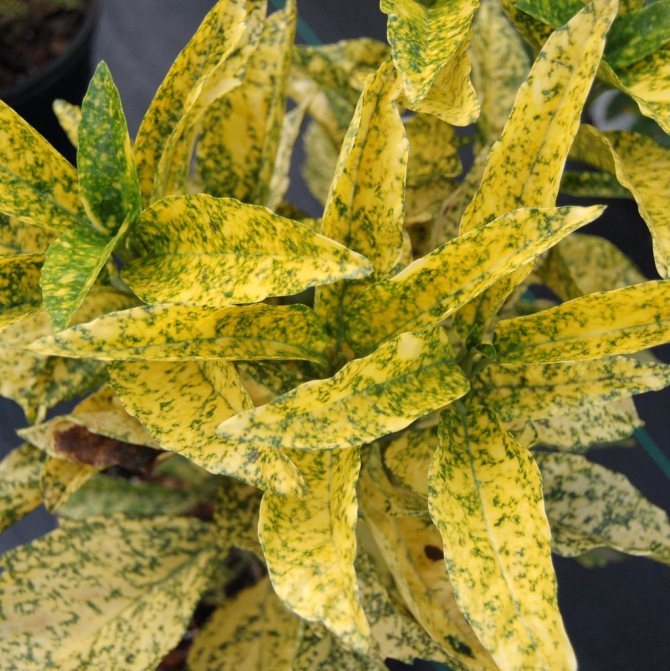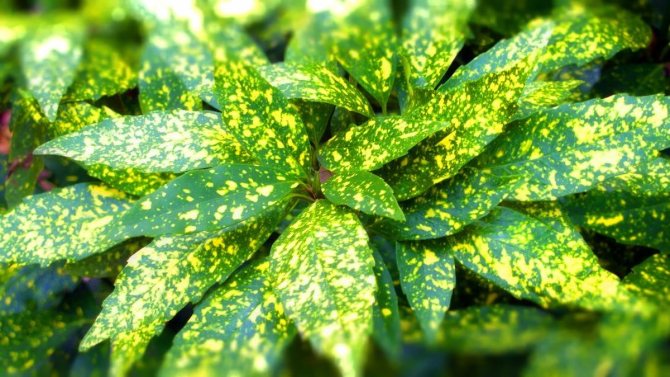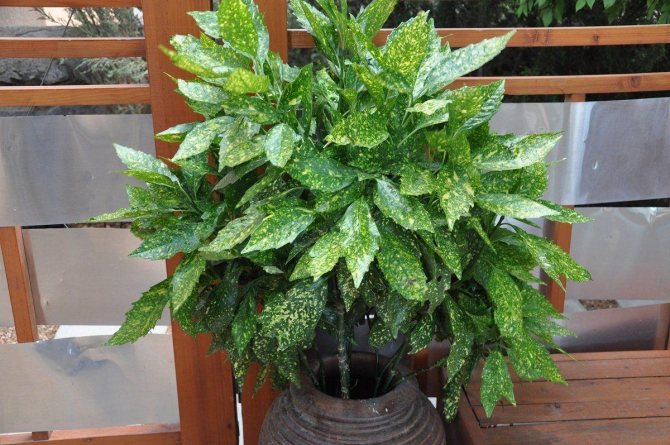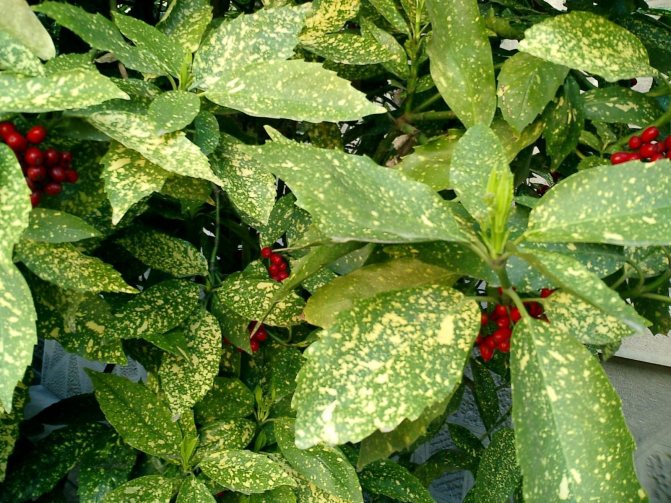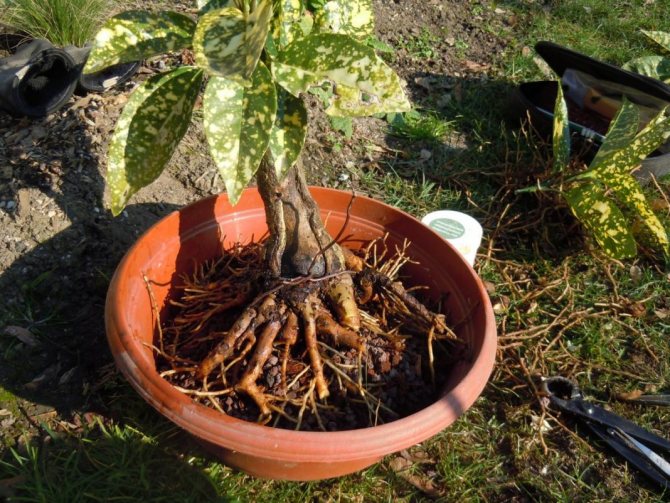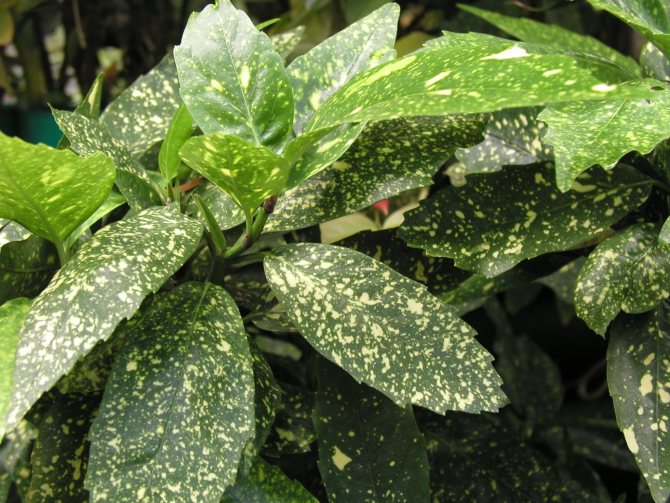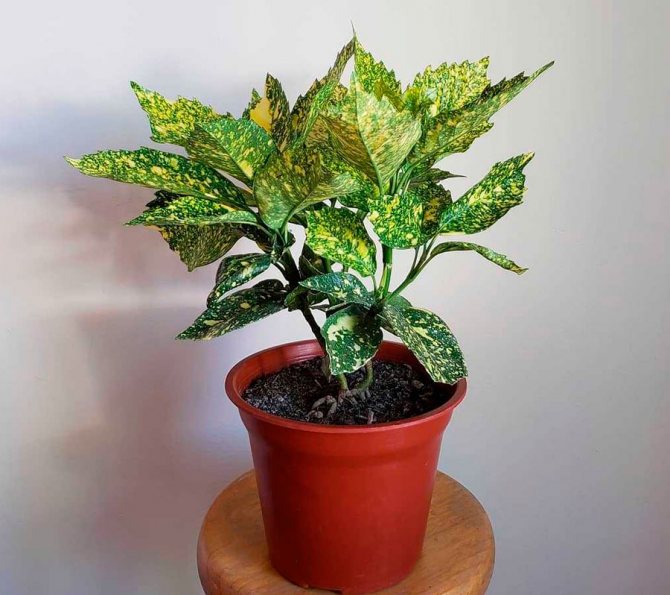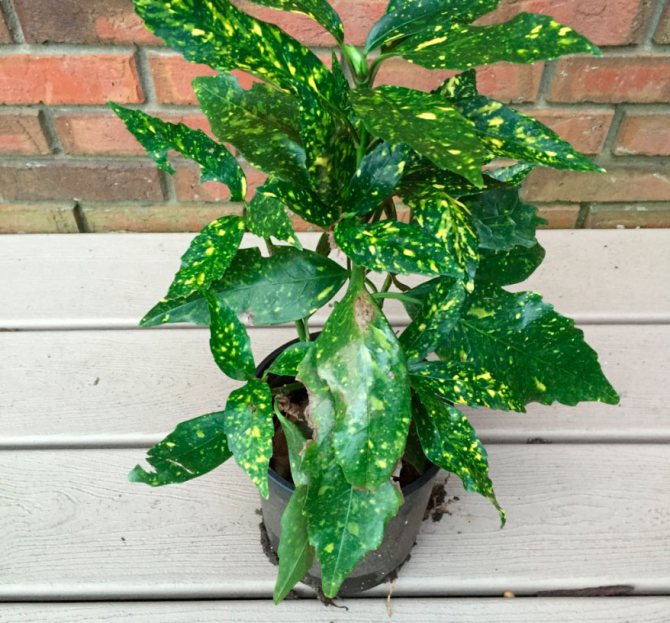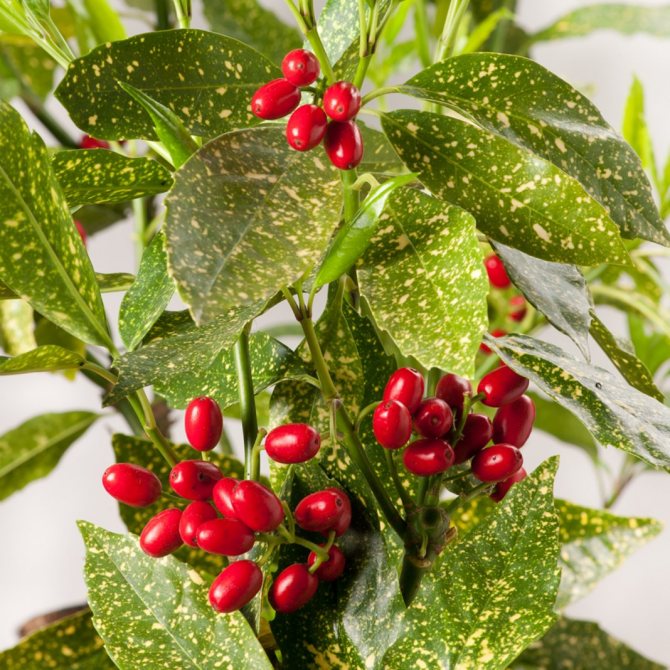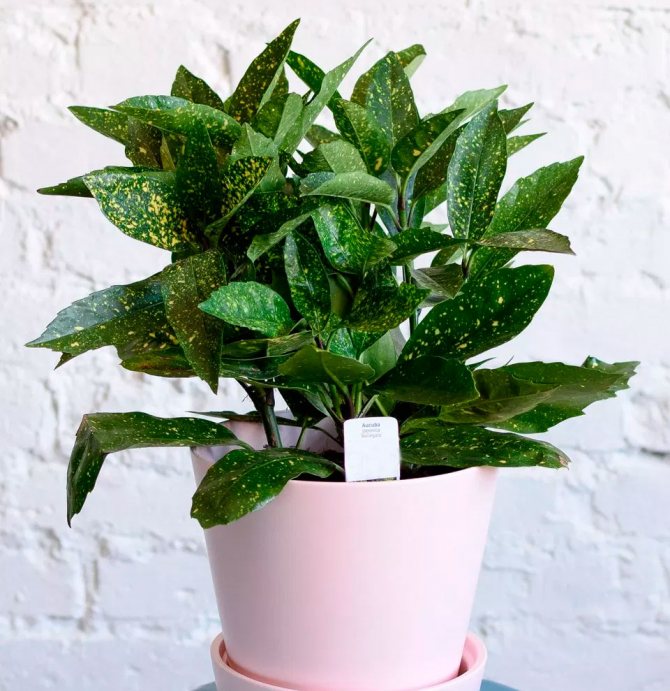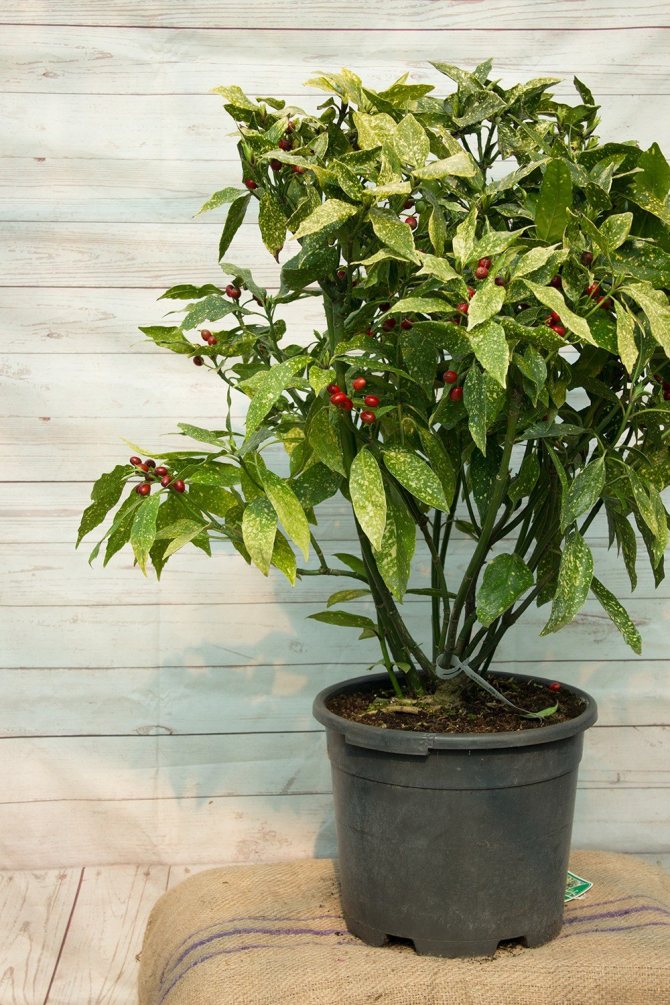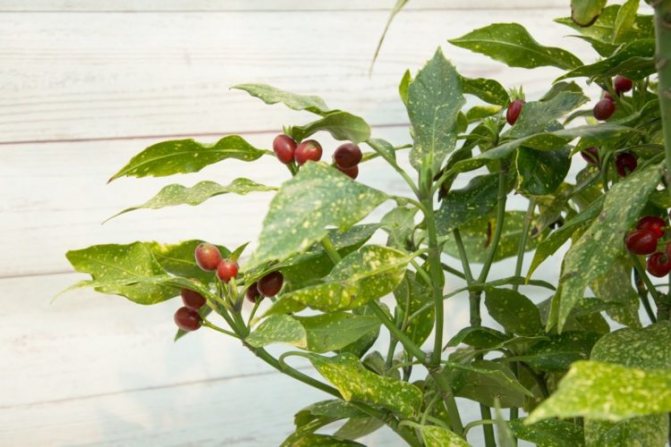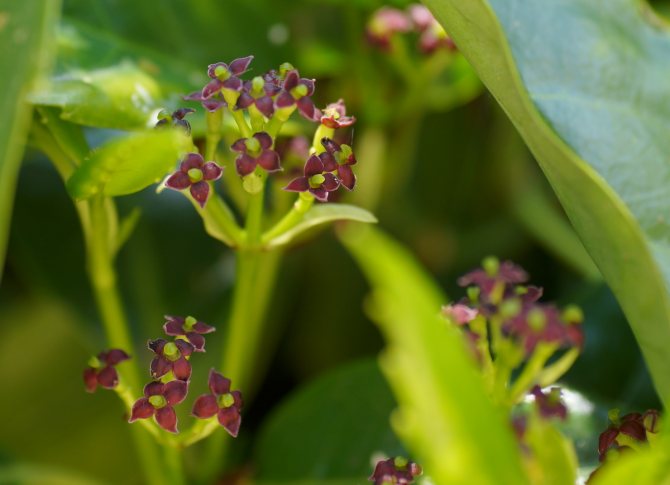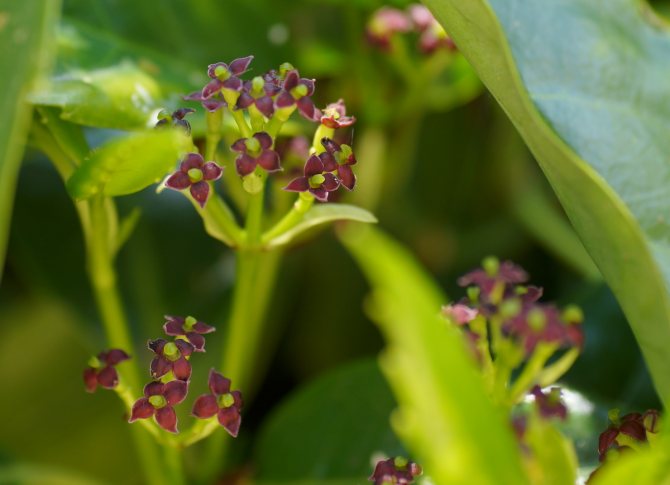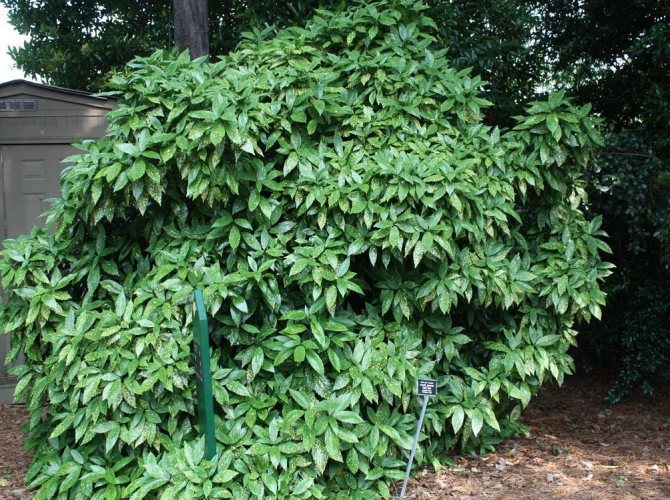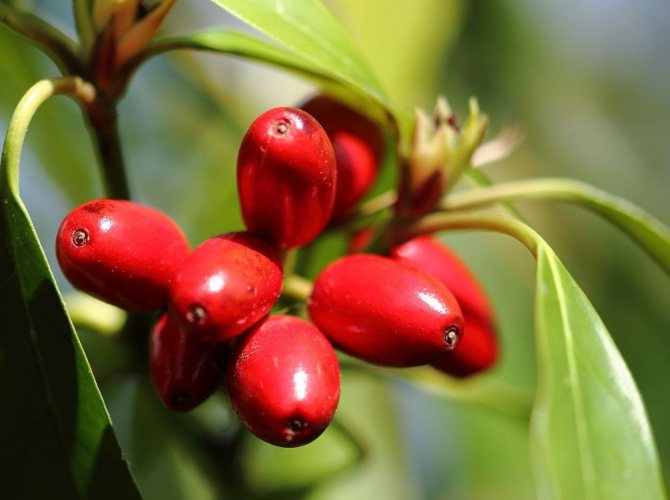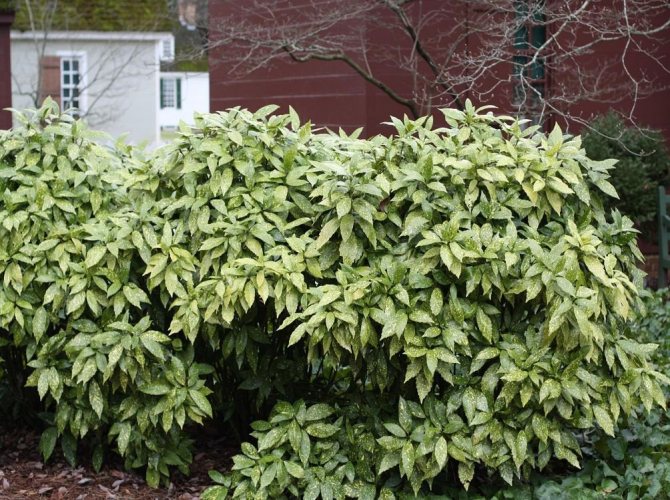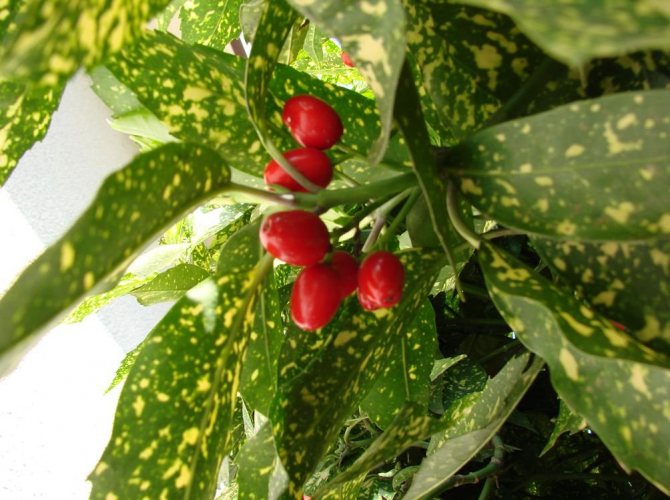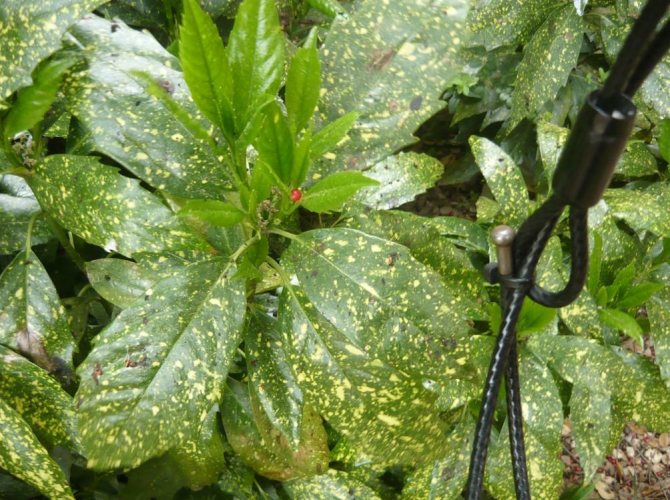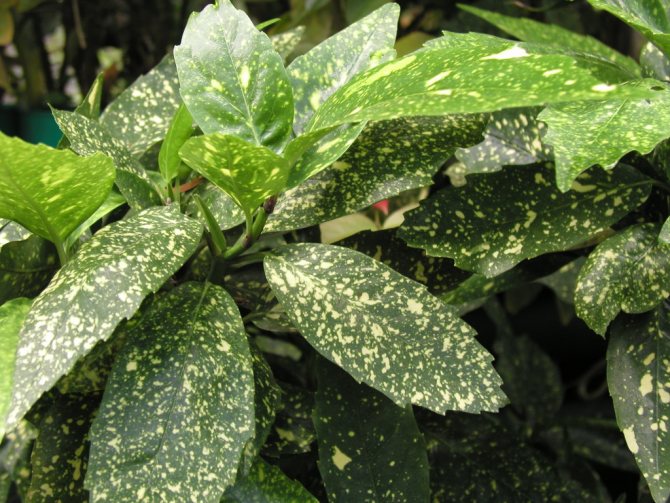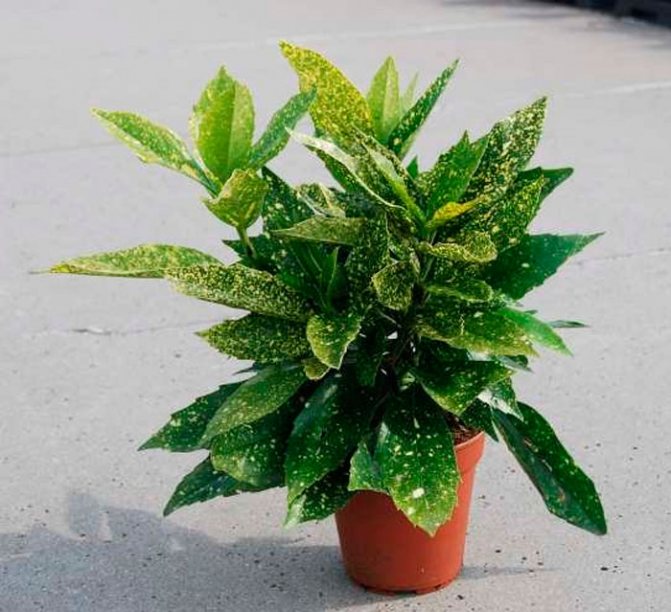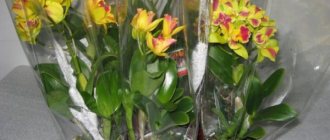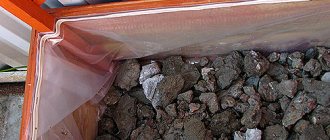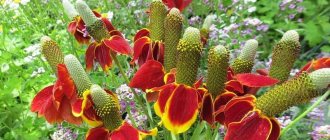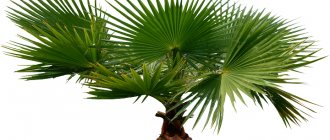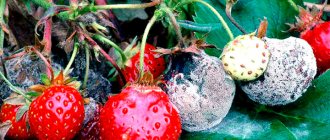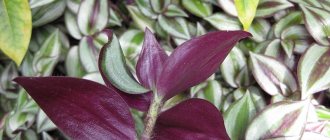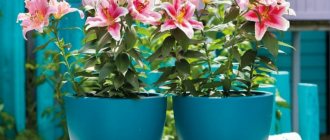There are not so many shrubs and trees among ornamental deciduous plants. The most interesting variations of speckled patterns on luxurious leaves are offered by the rare, but therefore even more valuable, aucuba. Despite the presence of bright berries and many unique features, it is for the drawings on the leaves that this beauty is considered one of the brightest exotic plants. Aucuba is far from the easiest plant to grow. But all she needs is a cool hibernation and regular routine care.
Japanese Aucuba (Aucuba japonica). <>
Plants of the genus Aucuba (Aucuba) represent the family in room culture Gariev (Garryaceae), although earlier they were referred to as Kizilovs. This plant is a typical inhabitant of humid subtropics. Aucubus can only be found in nature in the forests of East Asia. As an ornamental plant, the aucuba began to be considered immediately after its import into Europe; by the beginning of the 19th century, the plant had spread widely in indoor and greenhouse culture.
Aucuba are dioecious evergreen shrubs and trees. Even in nature, their maximum height is limited to 3 m. The leaves are opposite, large, lanceolate or oval-lanceolate, with a pointed tip. Shoots are thin, but strong. Basic species are rare, supplanted by varieties and decorative forms with original small or large specks on the leaves. Aucuba blooms can be disappointing, but when the male and female plants are grown and cross-pollinated, very beautiful berries mature afterwards. Outwardly, the fruits of the aucuba most of all resemble those of the dogwood.
In room culture, aucubi are represented mainly by a plant that has earned the nickname sausage or golden tree - aucuba japanese (Aucuba japonica). Shoots are green even after lignification. The oval-lanceolate or ovate-lanceolate leaves of the plant appear elegant and bright. The maximum length of the leaves is up to 20 cm with a width of about 6 cm. The edge of the leaf can be either solid or serrated. On a bright green base color, specks and spots of the most different sizes and shapes appear, but always golden in color. The play of the speckled pattern on the bright surface was the reason for the nickname of the sausage tree. The speckled patterns really resemble a slice of sausage or a piece of gold-bearing rock. With cross-pollination, bright red fruits are tied on the bushes.
The basic variety, the species plant on sale, is quite rare. Japanese Aukuba is represented mainly by varieties and decorative forms. The most popular and remain today:
- variegat with small gold specks over the entire surface of the leaf;
- painted form with a yellow center and dark green edges of the leaf blades;
- marble form with a beautiful creamy golden speck on the leaves;
- long-leaved form with narrow lanceolate leaves, outwardly somewhat reminiscent of willows;
- golden form with almost yellow foliage;
- palmate form with decorated toothed edges of elongated oval leaves;
- croton-leaved form with white and golden spots on the leaves;
- variety "Gold Dust", in which, under the numerous specks on the leaves, the base dark green color is almost invisible;
- dark-leaved variety "Hillieri".
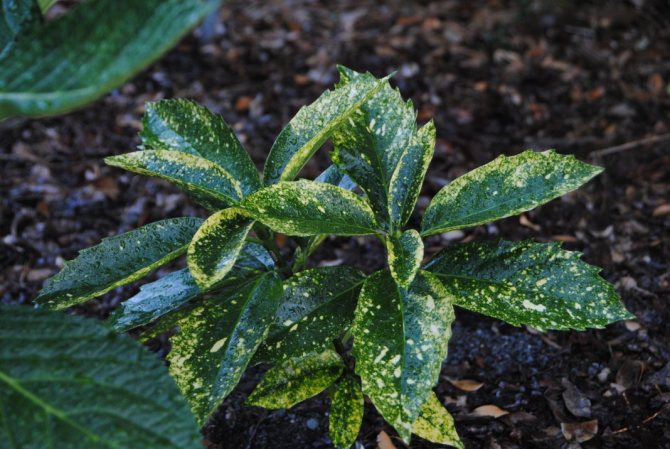
Aukuba is a Japanese variety "Daisuke's Tiger".
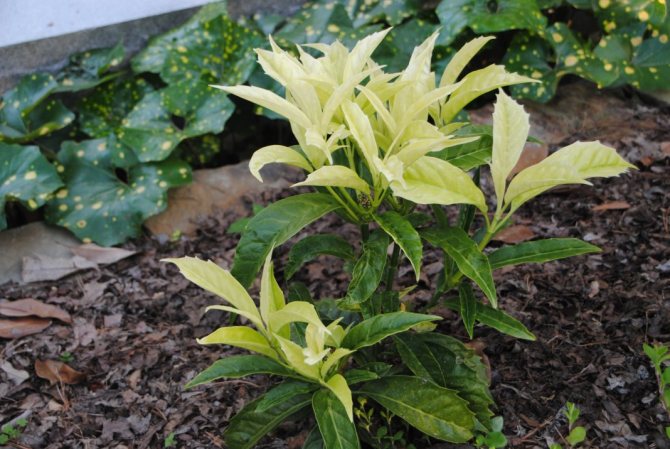

Aukuba is a Japanese variety "Natsu-no-kumo".
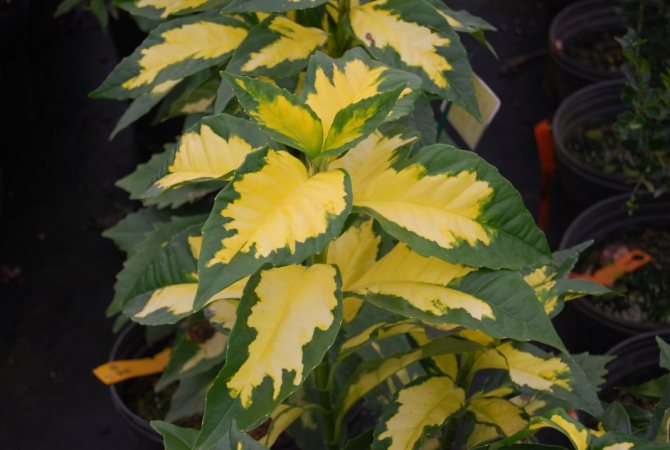

Aukuba is a Japanese variety "Ooba Nakafu".
In addition to Japanese aucuba, it is found on sale and aucuba himalayan (Aucuba himalaica) is a larger plant with dark green, lanceolate leaves and bright orange berries. The patterns on the leaves are faded, and the base color itself is a muted dark green. Due to narrow leaves and less brightness, it is considered a less attractive plant.
Types of aucuba for home cultivation
Japanese Aukuba is a bush native to the southern part of the Korean p-o. It is also called variegated, "golden tree", because in some varieties the foliage shines in the sun like a precious metal. The plant has attracted tourists for a long time, but the Japanese protected it from strangers, prohibited export from the country, believing in the magical and healing qualities of the shrub. It appeared in Europe only in the eighteenth century.
It is an evergreen plant with large, dense, oval leaves and a powerful tree-like trunk. In some varieties, the ends of the leaf plates have denticles. The color is dark green or with gold interspersed in various shapes and sizes. A shrub grows up to two to five meters. Flowering begins in early spring. The flowers are dark red, panicle-shaped inflorescences. The bush rarely bears fruit when it is kept in an apartment. If it bears fruit, the berries are fiery red or red (sometimes snow-white or emerald). The plant is poisonous, but it is still used in alternative medicine.
Aucuba Himalayan grows up to three to four meters in the wild. The foliage is dark green, the plates are lanceolate-oblong with an elongated or short pointed at the end. The flowers are small, unremarkable, unisexual.
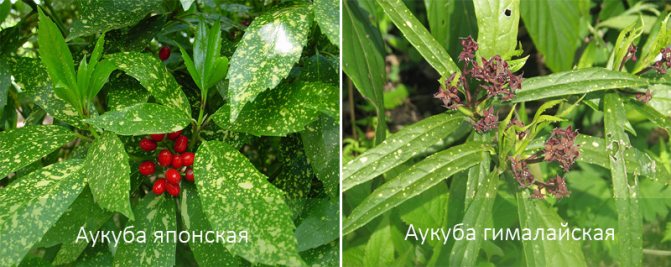

Description of the plant
First you need to understand what a golden tree is. This approach will give a complete and correct understanding of the nuances associated with caring for this plant.
This evergreen shrub is found in many eastern countries, including China and Japan. The Aucuba shrub chooses high ground, often settling in the Himalayan heights. This bizarre variety came to the Western world a long time ago, in the 17th century.
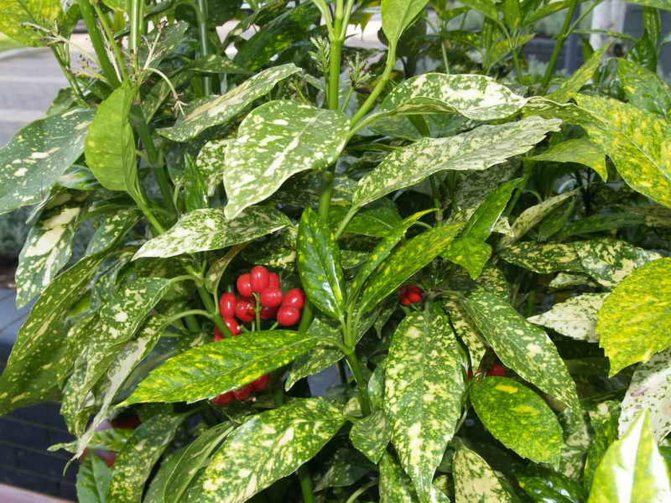

Since then, breeders have been working on developing new types of shrubs that collect all known shades and shapes. The Aucuba genus consists of 10 varieties, the species diversity can interfere with a beginner who gets confused by acquiring something specific.
Aucuba varieties
- Japanese look
Japan is considered the historical homeland of the Aucuba, most likely because of this, the most picturesque plants are concentrated on the territory of this country. The stems of a beautiful shrub are gradually covered with bark, which adds rigor and clear, regular forms to the plant.
Leaves emanate from the petioles and are located opposite each other. The slightly pointed leaf blade is organically combined with bright fruits, which are tied, as a result of proper pollination of the plant.
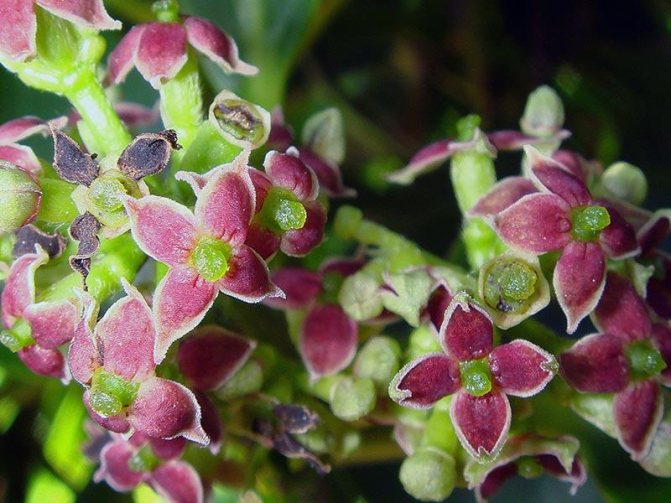

Of course, the Japanese variety also has several subtypes, the differences are mainly visual, including the following types:
- Gold Dust,
- Variegata,
- Dentata.
- Himalayan Aucuba
The color of this plant is dominated by green tones, golden shades are expressed in small dots, they are randomly located on the leaf plates. The variegated inflorescence contrasts against the background of strict leaves, to be sure of the scarlet berries that neatly adorn the entire shrub.
You will have to choose from these varieties, which greatly simplifies the final decision. In general, the aucuba can be described as a very beautiful, catchy and noticeable plant of large size.
In the wild, the dimensions of the shrub can exceed 4 meters, however, indoors or in private property, the dimensions are easily adjustable. Thus, the average height of a domesticated plant is only 1.8 meters.
The dense structure of the shrub is provided by an abundance of adventitious shoots that densely cover the branches, growing almost from the ground. The bark of the shoots is distinguished by a characteristic color, which is notable for dark stains in the lower part of the epididymis.
You can also recognize aukuba by its unique property, it consists in preserving traces of already fallen leaves on the bark. Thus, you can observe the entire history of the plant directly on its cover.
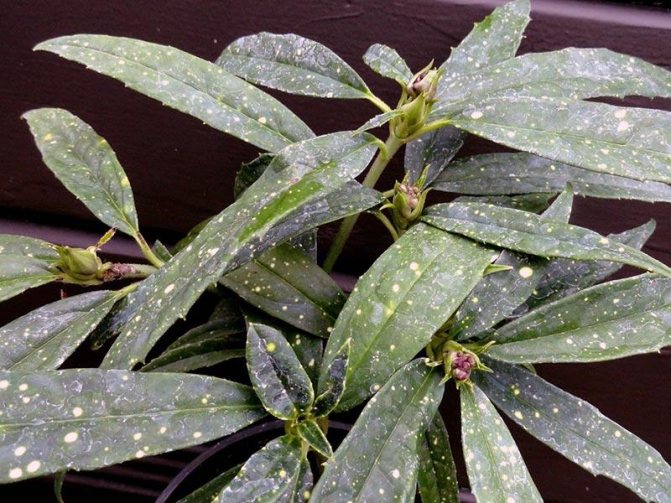

The leaves themselves are small, about 13 centimeters long. The edges of the plate are decorated with small teeth, and the whole area, as you remember, is covered with yellow streaks or lines. However, modern breeders offer aucubes not only with golden tones, but also with other contrasting colors.
Be prepared to wait a long time for flowering, as the plant is extremely demanding on this score. But, with proper attention and care, you can enjoy the dense tassels of flowers that form in late winter and last until mid-spring. What are the problems hindering flowering?
First, the aucuba is a dioecious, that is, a heterosexual plant. Therefore, it will be possible to buy only a male or female individual, which will have to be pollinated using the opposite sex.
Flowering naturally gives way to catchy berries that look very appetizing. This impression is deliberately created to scare away predators. However, this is just one of the remedies that the aucuba has.
Important! The plant is very poisonous, toxins are found both in berries and leaves with stems.
Consequently, only those who do not have pets and will not allow small children to come to the flower can become the owner of the bush.
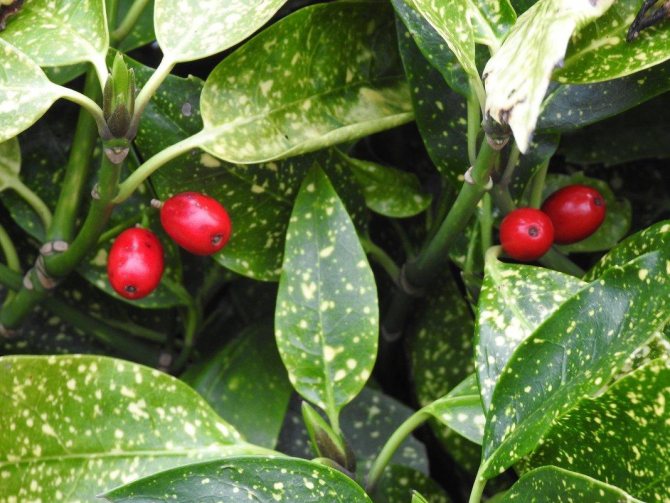

Remember that safety is always above beauty, so take care of the safety of the plant from your roommates.
By the way, the fact that a poisonous and dangerous plant exudes a useful smell can be called strange. Aucuba scent perfectly purifies the surrounding atmosphere and helps to stop the spread of viruses and bacteria.
Aucuba care at home
Aucuba tolerates home conditions well, grows quickly, rarely gets sick. The plant does not require special care and has the following positive qualities:
- calmly tolerates low temperatures (not lower than + 8 ° C);
- resistant to weak or, on the contrary, too intense light, but for a short time;
- retains its decorative appearance even in an unfavorable environment for growth;
- does not die with sudden temperature changes.
If the bush is well looked after, it blooms and can even bear fruit. However, this requires two specimens of the plant (male and female), because it is dioecious.
Summer care
Aucuba does not tolerate too high a temperature, the optimal one is + 20 ° С. When the mark on the thermometer exceeds this figure, it is recommended to rearrange the flower in a shady and cool place. Otherwise, the foliage will begin to fall off the plant, this will negatively affect the further development of the bush. In summer, the aucuba feels good outdoors (for example, on a loggia or balcony). In this case, the pot with a flower must be covered if it is raining or strong winds outside.
In the summer, you do not need to spray the bush, provided that the room is regularly ventilated. Watering is necessary regularly; strong drying must not be allowed. It must be borne in mind that the plant does not like excessive moisture. Stagnant water will cause dark spots on the greenery. Top dressing is done in spring with universal complex fertilizers for decorative deciduous plants (preferably by spraying).
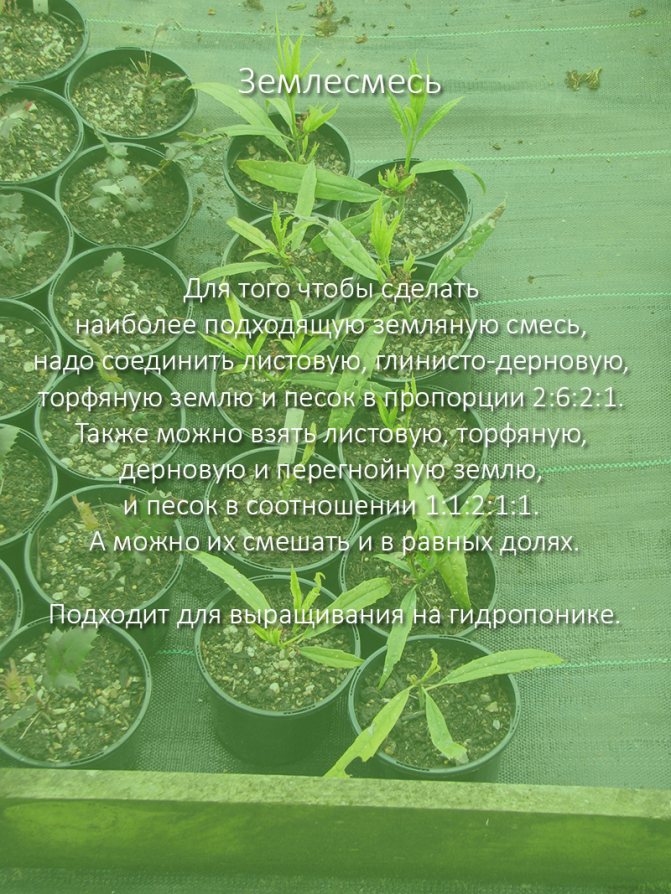

In winter
In winter, the optimum temperature is + 14 ° С. It can be lowered to + 8 ° С. With intensive operation of heating devices, aucube must be sprayed with warm settled water.Watering is done as needed when the soil dries up.
Diseases and pests of Japanese aucuba
Rot is the greatest danger to the aucuba. With any excess moisture or the wrong choice of dense soil, the plant suffers greatly, black spots appear on the leaves, indicating a problem. With its timely identification, you can cope with it with a simple correction of care. Emergency transplants are ineffective: root injuries most often lead to the death of the plant.
Of the pests on aucuba, only mealybugs and spider mites are found, which are best dealt with immediately with insecticides.
Common growing problems:
- discoloration, loss of spots with insufficient lighting or depletion of the soil;
- blanching of leaves in too bright light;
- leaf fall in the absence of fertilizing;
- yellowing of the lower leaves with gradual subsidence: temperature fluctuations or problems with watering;
- drying of the top and yellowing of the upper leaves when the light is too bright;
- shrinking leaves with improper feeding and depletion of the substrate;
- the appearance of black spots on the leaves during warm wintering without compensatory care.
How does aucuba bloom and is it possible to keep it at home
Flowering is observed in the first half of spring. The reddish-brown flowers are gathered in panicles. Male and female inflorescences are located on different plants (it is impossible to identify gender before flowering). At the end of April-May, fruits appear on the bush.
Although poisonous, aucuba is often grown at home. Leaves, flowers and fruits are dangerous. Therefore, you need to be careful with the bush.
It is better to move the aucuba higher so that children or pets cannot reach it. After planting or pruning shrubs, hands should be thoroughly washed with soap and water. If the juice enters the stomach or intestines, an inflammatory process will begin in the organs, the victim will be tormented by bloody diarrhea.
Growing problems
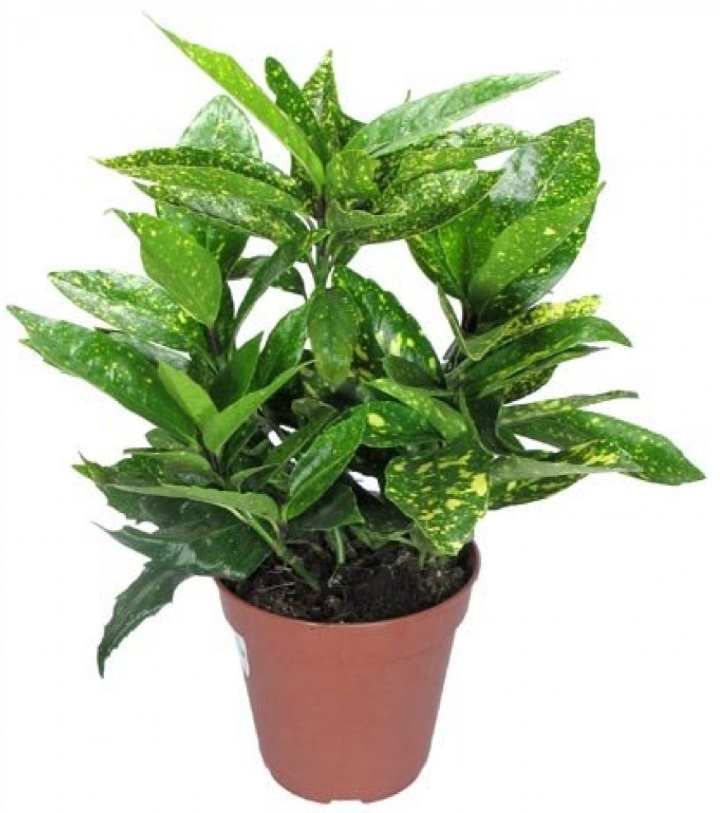

leaves lose their color - too bright sunlight;- loss of leaf pattern indicates a lack of lighting;
- the plant has too small leaves - it needs timely feeding with mineral and organic fertilizers;
- falling leaves signals an increased temperature of the content and low air humidity;
- yellowing and falling of leaves occurs due to temperature jumps or irregular watering of the plant;
- if the edges of the leaves began to dry out, then it is worth creating additional shading for the plant, watering more often in summer and spraying in winter;
- dark spots on the leaves indicate a violation of the temperature regime during the dormant period and low air humidity.
How to achieve a beautiful crown from an aucuba
If a lot of shoots appear on the trunk in the spring, the plant needs pruning. After it, it will grow better. In order for the bush to have a beautiful, spreading crown, it is recommended to pinch.
Transplanting adult specimens to preserve decorativeness is not often done - once every two to three years. Young bushes - annually.
Aucuba has a fragile and fragile root system. Therefore, when transplanting, you need to be careful and carry out it using the transshipment method.
In order for the flower to grow intensively and maintain a beautiful appearance, loose soil is taken for planting. It is recommended to use a mixture of two equal parts of peat, leaf, six - sod land and one sand.
When working with a shrub, it is important to remember about safety precautions: perform all actions with gloves, do not forget to wash your hands, and avoid getting juice on the mucous membranes.


Application
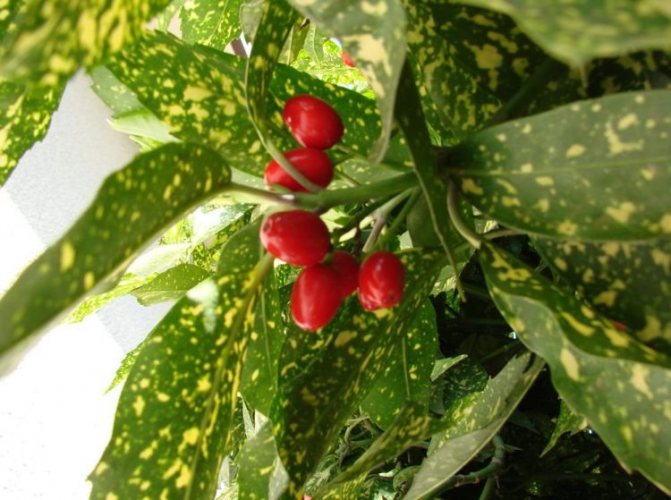

The aucuba plant has not received widespread use, except as an ornamental one, but sometimes it can be useful in different industries. Read and find out which ones.
In medicine
Even in ancient times, oriental healers used the leaves of the aucuba for medicinal purposes.They are great for healing burns and frostbite, the latter of which are not uncommon in the mountains of Tibet. On the basis of plant parts, decoctions and tinctures were prepared against gastrointestinal diseases. However, this applies only to wild species of aucuba, since domestic ones, as a result of selection, ceased to have any miraculous properties.
At home
Aucuba is an evergreen plant, and the fleshy leaves contain a lot of valuable chlorophyll, which is needed for the plant to photosynthesize. From this it follows that there will always be more oxygen in the room with the aucuba.
Reproduction
Aukuba is propagated by:
- seeds;
- by cuttings.
For reproduction at home, the second method is usually used. Planting is best done in March or late August-September. It is done as follows:
- Cuttings are cleaned of greens, leaving only two or three leaves.
- For good rooting, shoots are planted in a moist substrate of equal parts of peat and sand.
- Containers with seedlings are covered with polyethylene.
- The bushes are periodically opened and ventilated, condensation is removed from the shelter.
- Young plants are kept at a temperature of + 20 ... + 22 ° С.
- Rooted shoots are transplanted into separate pots with a diameter of 7-8 cm.
When growing heterosexual plants, they must be pollinated on their own. Only in this case will seeds appear for further reproduction. Planting material loses its germination capacity very quickly, so it must be sown immediately. It should also be borne in mind that varietal traits with this breeding method may not be transmitted.
Seeds are planted in moist soil of peat or sand. The seedlings are covered with polyethylene and regularly ventilated and sprayed with warm, settled water. The recommended room temperature is + 21 ° С.
The emergence of seedlings takes a lot of time (several weeks). When they hatch, the shoots will have two or three leaves, they can be transplanted into a separate pot or into open ground of medium acidity.
Care secrets
The houseplant aucuba does not require increased attention to itself, but the basic growing conditions must be strictly adhered to. She feels great in shade and partial shade, which allows her not to be placed on the windowsill, but to be placed in the opposite part of the room. In an apartment, a golden tree reaches 1-1.5 m, but it will grow subject to temperature conditions, proper watering and lighting.
Temperature
In summer for the plant, the optimum temperature will be up to + 20C, but not higher. Otherwise, it will begin to lose foliage. Sometimes you can take the plant outside, but only in the shade, away from drafts and wind.
In winter, the bush begins a dormant period, and the temperature should not exceed +8 + 12C. If this is not possible, then the plant will have to be additionally highlighted and sprayed.
Lighting
Direct rays for a flower are destructive, and in the summer, a slight diffused light is enough for it. It will grow well in partial shade, but only in summer. In winter, he needs additional lighting.
Humidity and watering
The plant is not demanding on humidity in the apartment, therefore, it is rarely sprayed in the summer. For this, soft filtered water at a comfortable temperature is suitable. It is imperative to spray aucuba in winter., especially if the room temperature exceeds + 14C. If the room is colder, then spraying is carried out with caution to avoid the development of fungus.
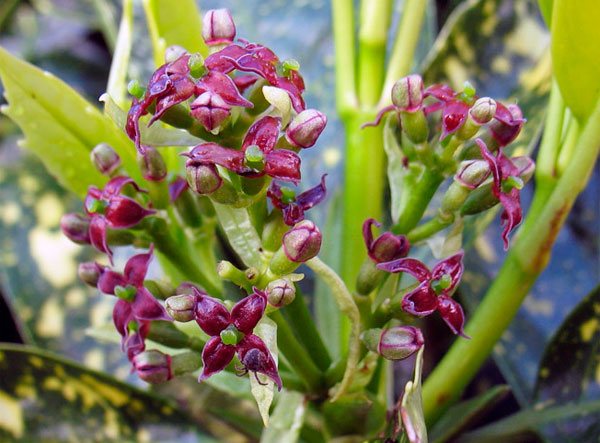

In the summer, regular abundant watering is required, as the topsoil dries up. In the autumn-winter time, watering is sharply reduced. The golden tree tolerates drought much more calmly than waterlogging. Excess moisture causes blackening and leaf fall, the development of rot and death of the flower.
Top dressing
Like any houseplant, the aucuba needs periodic soil fertilization.The procedure should be carried out in spring and summer, weekly, using organic and mineral dressings in turn.
This article is about the eschinanthus plant and how to care for it at home.
And everything related to the houseplant murraya, you will find here.
Many will find our recommendations for growing a heliotrope flower useful.
Pruning
Aucuba is pruned annually in early spring. Be sure to cut off all the shoots from the tops and pinch the lateral processes. This will add decorativeness and splendor to the bush, improve development.
Transfer
The first time an aucuba is transplanted to a permanent place a few days after purchase.
The plant prefers spacious containers with holes in the bottom and a thick drainage layer. The roots of the bush are very brittle and fragile, which requires special care and accuracy.
Transplanting is carried out by transshipment of a plant with an earthen clod on the roots.
Pre-prepare the soil:
- 2 hours of leafy soil;
- 6 hours of sod soil;
- 2 tsp peat;
- 1 tsp sand.
A young aucuba should be replanted annually, and an adult plant should be replanted every 3 years, as the pot fills with roots. Immediately after the procedure, it is necessary to pinch the tops of the shoots, and the next day to water.
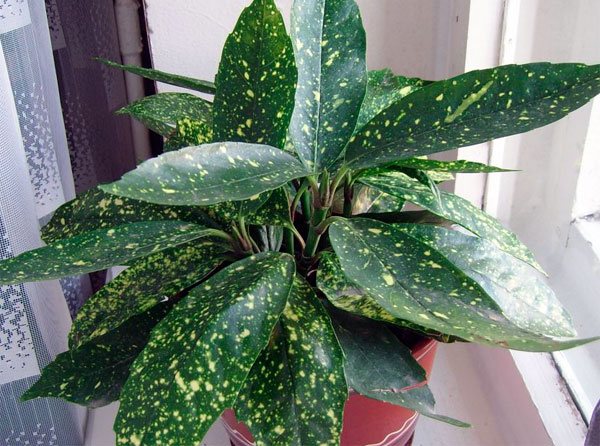

Mister Summer Resident: Aucuba Assistant
The flower not only looks beautiful, but also has healing properties. The foliage of the bush contains useful elements that contribute to the destruction of pathogenic microorganisms in the air.
The plant is used in alternative medicine to treat injuries, burns, frostbite. Aucuba compresses are applied to the affected area, changed regularly. They reduce pain, disinfect wounds, and promote early healing. In addition, various diseases of the gastrointestinal tract are treated with preparations containing aucuba extract. In this case, it is very important to observe the dosages indicated in the prescription, consult a doctor in advance so as not to harm your health.
The Japanese believe that the plant is beneficial for family relationships. It brings relatives closer and unites. Thanks to the shrubs, peace, understanding and harmony will reign in the house.
Buying a flower brings prosperity not only to family members, but also to apartment guests. In addition, the aucuba helps to get rid of the negative energy brought into the home by ill-wishers.
According to an ancient Japanese legend, the plant attracts luck and wealth to the family. Caring for an indoor flower promotes a surge of vitality, helps to unleash potential, and gives self-confidence. Aucuba will be a wonderful gift for an indecisive and withdrawn person.
Types and varieties of plants, appearance
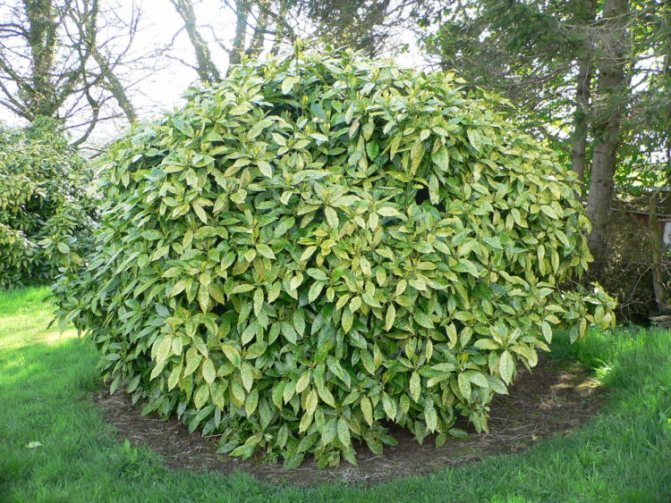

Aucuba is best known as a houseplant. It is evergreen, with large leathery leaves gathered in a bunch. Thanks to the yellow spots and blotches, the aucuba got its second name - the golden tree.
The Aucubaceae family of plants consists of 3 species, many subspecies and varieties. They differ from each other in color and shape of leaves, flowers, berries.
Golden tree and signs
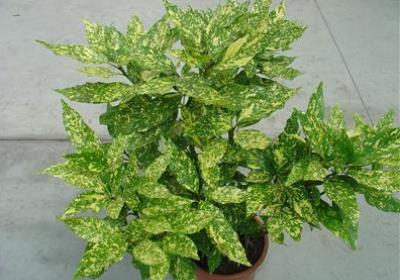

Residents of the east believe that aucuba improves the microclimate in the home, helps the family become stronger, and restores harmony and peace in relationships.
And this is felt not only by the permanent residents of the house: even the guests note how much positive energy, warmth and good nature are around.
Taking care of the "golden tree" sincerely and from the heart, you attract prosperity and happiness to your home, you get new strength and even the potential hidden for the time being becomes clear to you. And if there is a shy, indecisive person in your environment, give him a pot with an aucuba sprout. Stretching out, the plant will help your friend become more self-confident, become bolder in communicating with the opposite sex.
Pests
The main pests of the aucuba are aphids, spider mites and scale insects.
In order to deal with these nasty insects, follow the following diagram:
- Separate the diseased plant from the rest in a quarantine area. By the way, it is imperative to endure quarantine even when a new green friend appears in your house for the first time. A week will be enough: during this time, you will be able to identify if there are larvae or adults on the plant of dangerous pests or signs of diseases that are dangerous to others.
- Pick adult insects with your hands, then wash the plant in a warm shower using green or tar soap. Cover the pot with plastic to prevent soap from getting into the ground. Thoroughly wipe each leaf on both sides and stem with a cotton cloth soaked in soapy water.
- Treat the houseplant with a suitable chemical: Fitoverm, Trichopol, Aktofit, Fufanon, Strela, Jaguar. If the degree of damage is small, you can try folk remedies. This is a tincture of tobacco, potato tops, onion husks, a decoction of wood ash and liquid soap.
When dealing with insect extermination, remember your own safety: keep the dosages indicated in the instructions, protect your eyes, nose and mouth with special masks, wash your hands after each procedure and in no case use drugs inside.

